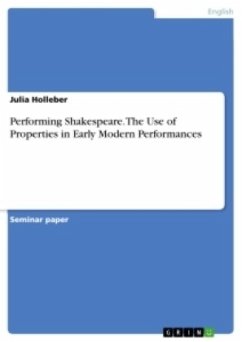Seminar paper from the year 2019 in the subject English Language and Literature Studies - Other, grade: 1,0, University of Würzburg, language: English, abstract: The aim of this scholarly exposition is to give a brief introduction into how the various places of performances affected the use of properties on the Early Modern Stage. After introducing the two main playhouses of Shakespeare's company the King's Men, the Globe and the Blackfriars, the properties commonly used by the players will be examined. When thinking of Early Modern Theatre, the Globe is one of the first things that come to mind, being "an icon of English dramatic and literary history and one of the most famous buildings in the world". The outdoor playhouse, built by the company the Lord Chamberlain's Men of which Shakespeare was a member, opened in 1599 and was located at the south bank of the River Thames in London. Even though many of the company's performances took place there, this was not the only location they used for staging Shakespeare's plays. By 1611, the company which was now called the King's Men, also performed in the indoor playhouse Blackfriars, at court or in private houses by invitation. Additionally, the company went touring through the country. As the actors performed in many different locations, they had to adapt the staging of the play to the changing circumstances.








